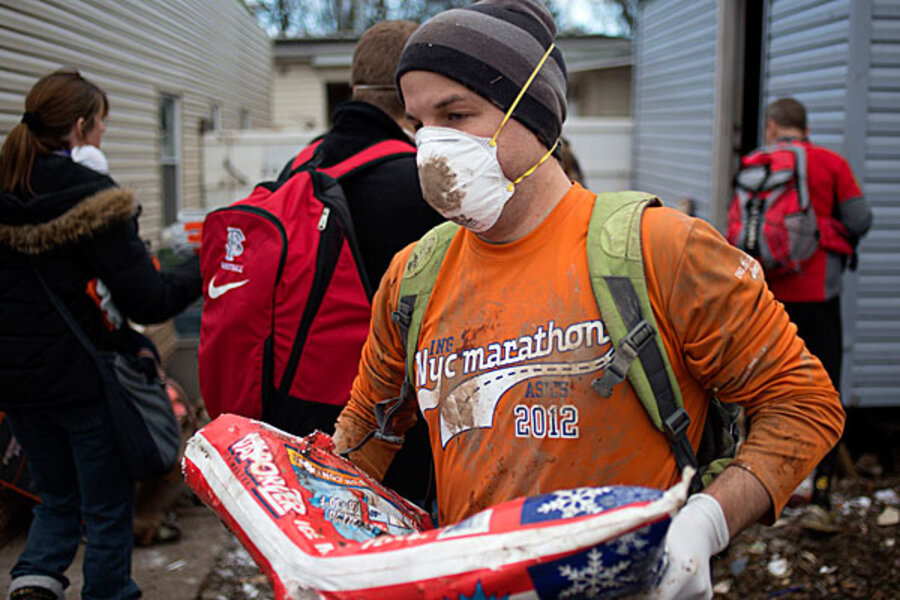New York City marathon runners redirect energy into charity
Loading...
| New York
Even though their race was called off, marathoners were still on the move in New York on Sunday.
Hundreds of runners wearing marathon shirts and backpacks full of supplies took the ferry to hard-hit Staten Island and ran to stricken neighborhoods to help. Thousands of others poured into Central Park to put in 26.2 miles after the official cancellation of the world's largest marathon because of Superstorm Sandy.
"A lot of people just wanted to finish what they started," said Lance Svendsen, who organized an alternative marathon called Run Anyway. By 8:45 a.m., his group had sent off five waves of runners from the marathon's official finish line, which had not yet been taken down. "It is amazing. My guess is about 600 people have left so far."
IN PICTURES: Sandy: Chronicle of a superstorm
Italians stretched en masse near the Plaza Hotel. The Germans started from Columbus Circle. Everyone plunged into the park to pursue their own race. Some ran around the park clockwise, some counterclockwise, taking over startled dog walkers with a riot of color.
It was a throwback to the original New York City Marathon in 1970, which was run ragtag with 127 people and stayed completely within Central Park This time, some dropped off clothing and other supplies for storm victims.
This year's runners all are guaranteed entry into next year's race, but not everyone could be sure that chance would come.
"I'm in the military, and I could be deployed," said Ruben Arredondo, 36, of Los Angeles, who showed up outside the park at 6:45 a.m. to join a group called the Replacement Marathon, which had been organized online just hours before.
The morning surge surprised even some participants and their fans. Tracey Busch, of New Jersey, was near the finish line with a small cowbell in each hand, cheering on passing runners who weaved through the crowd of organizers, tourists and media.
"It was kind of eerie because initially there was no one, and then suddenly there was everyone," said Busch, who had arrived around 7 a.m.
Runners refueled at hot dog stands and dodged cyclists and strolling tourists.
"This is the great power of running," said Vincent Laiz, 37, who came from Spain. Seconds later, his impromptu and international group counted down the seconds, in German, to 8 a.m., whooped and set off.
Some, like a team from Bermuda, hadn't fully shaken the sadness of the cancellation. "It's like when you find out that Santa Claus isn't real," said Spencer Conway, 30, who had turned his country's flag into a cape.
Many runners found a way to volunteer for storm victims. On the steps of a statue just outside the park at Columbus Circle, a newly created group called Run4All was collecting donations in cardboard boxes.
"A lot of people brought extra clothes," said Gabriella Moreno, 23, from Mexico. She was amazed by the waves of runners but said she understood their drive.
"If you've shaped your life around something for so long, what's stopping you?" she said.
On Staten Island, the runners with backpacks emerged from the ferry for a quick, emotional briefing.
"The devastation and damage you are about to wander into," said Staten Island resident Jonscott Turco, who paused, almost teary. "It's pretty extraordinary. The only thing I can prepare you for is they're still finding people, remains."
The landscape worsened as they approached the waterfront. Shuttered gas stations. Long gas lines, with people asleep in their cars.
One man honked and yelled, "There's no marathon! Go home!" But people standing outside one deli yelled encouragement: "Thank you, ladies!" ''God is good""
Near the water, there were no traffic lights and far more sirens. Houses looked like they had been sacked. Furniture was in front yards, washing machines, TVs.
But one man came out of his home and asked if the runners had flashlights, and they did. At another house, a family wearing face masks asked for batteries and sweatshirts. They said, "God bless you." The man said, "Let me take your picture."
For runner Hana Abdo, the whole scene was striking. When she found out the marathon had been cancelled, "I was almost in tears because I've been training for two years," she said.
"But what is two years of my life to somebody's whole life?"
IN PICTURES: Sandy: Chronicle of a superstorm
Copyright 2012 The Associated Press.







